67 start with S start with S
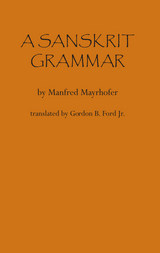
Translated for the benefit of Englishspeaking students of Sanskrit and students of comparative Indo-European linguistics. Mayrhofer's Sanskrit grammar can be used successfully in three different types of course: in elementary Sanskrit courses along with such an elementary text as Jan Gonda's A Concise Elementary Grammar of the Sanskrit Language, with exercises, reading selections, and a glossary, translated from the German by Gordon B. Ford, Jr.; in courses where the linguistic structure of Sanskrit is to be presented; and, finally, in comparative lndo-European courses together with such texts as Antoine Meillet's Introduction to the Comparative Study of the Inda-European Languages, translated from the French by Gordon B. Ford, Jr. All three groups of students should find this important book extremely useful, and I hope that its publication in an English edition will promote the study of Sanskrit in the English-speaking world.

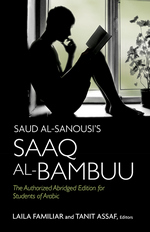
Saaq al-Bambuu (The Bamboo Stalk) by Kuwaiti novelist Saud al-Sanousi provides students at the intermediate-advanced Arabic language level the opportunity to engage with an award-winning work of contemporary fiction. This abridged version has been approved by the author, authenticating the richness of a text that offers students the means to develop vocabulary and reading fluency while sensitizing them to the stylistics of the language. The novel is a coming-of-age story of a half-Filippino, half-Kuwaiti teen who returns to his father's Kuwait. There, he explores his own identity as a poor Filipino in a culture he does not know well and receives a mixed welcome from his own wealthy relatives. Universal concepts of identity, faith, belonging, poverty/wealth, and otherness are explored through a poetic narrative and engaging plot that will keep students captivated from the first line to the very last page.
Included within the book are chapter exercises that develop linguistic and cultural competencies, a short biography of the author, and glossaries of literary terms and devices. As with Laila Familiar's Sayyidi wa Habibi, this authorized version of the abridged text by a contemporary Arabic author will be warmly embraced by college and university students of Arabic as well as by independent learners.

A detailed discussion by the editor complements this critical edition and translation of the phonetical treatise (Pratisakhya) of the Saunaka Samhita, one of two versions of the second oldest Indian text, the Saunaka Atharvaveda.
The 19th century edition of the text by W.D. Whitney has long been out of date; this reevaluation provides insights into early grammatical thought and helps to re-establish the textual tradition of the Atharvaveda. The book deals with the phonetically correct pronunciation of that text which has received only preliminary treatment thus far. It is also one of the few in its genre.
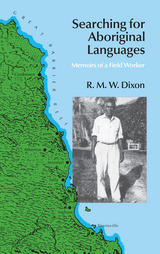
As he made his way through northern Australia, Dixon was dependent on rumors of Aboriginal speakers, the unreliable advice of white Australians, and the faulty memories of many of the remaining speakers of the languages. Suggestions of informants led him on a circuitous trail through the bush, to speakers such as the singer Willie Kelly in Ravenshoe, who wanted his recordings sent to the south, "where white people would pay big money to hear a genuine Aborigine sing" and Chloe Grant in Murray Upper, who told tales in four dialects of digging wild yams, of the blue-tongue lizard Banggara, and of the arrival of Captain Cook. Dixon tells of obtaining the trust of possible informants, of learning the customs and terrain of the country, and of growing understanding of the culture and tradition of his subjects. And he explains his surprise at his most unexpected discovery: that the rich oral tradition of the "primitive" Aborigines could yield a history of a people, as told by that people, that dates to almost ten millenia before.
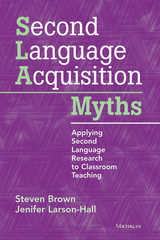
This volume was conceived as a first book in SLA for advanced undergraduate or introductory master’s courses that include education majors, foreign language education majors, and English majors. It’s also an excellent resource for practicing teachers.
Both the research and pedagogy in this book are based on the newest research in the field of second language acquisition. It is not the goal of this book to address every SLA theory or teach research methodology. It does however address the myths and questions that non-specialist teacher candidates have about language learning.
Steven Brown is the co-author of the introductory applied linguistics textbook Understanding Language Structure, Interaction, and Variation textbook (and workbook).
The myths challenged in this book are:
§ Children learn languages quickly and easily while adults are ineffective in comparison.
§ A true bilingual is someone who speaks two languages perfectly.
§ You can acquire a language simply through listening or reading.
§ Practice makes perfect.
§ Language students learn (and retain) what they are taught.
§ Language learners always benefit from correction.
§ Individual differences are a major, perhaps the major, factor in SLA.
§ Language acquisition is the individual acquisition of grammar.
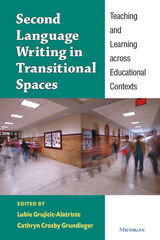
The chapters examine the writing that English learners are producing because of the Common Core and the writing they are required to do once they reach the college or university, and then consider where the intersections exist—that is, what do educators think English learners ought to be writing across educational levels?
Each chapter describes the educational setting where the researchers were engaged, examines specific issues related to transitions, and offers—where relevant—recommendations for classroom practices, teaching strategies, and instructional materials that may be useful for practicing teachers and all others professionally engaged in educating writers across K–16.

In the decades before the rise of the Third Reich, “Secret Germany” was a phrase used by the circle of writers around the poet Stefan George to describe a collective political and poetic project: the introduction of the highest values of art into everyday life, the secularization of myth and the mythologization of history. In this book, Furio Jesi takes up the term in order to trace the contours of that political, artistic, and aesthetic thread as it runs through German literary and artistic culture in the period—which, in the 1930s, became absorbed by Nazism as part of its prophecy of a triumphant future. Drawing on thinkers like Carl Jung and writers such as Thomas Mann and Rainer Maria Rilke, Jesi reveals a literary genre that was transformed, tragically, into a potent political myth.
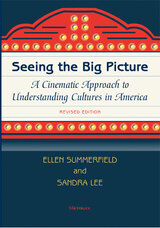
In addition to increasing students' knowledge and understanding of cultural differences, Seeingthe Big Picture will help students develop strong critical-thinking and analytic abilities as they learn to recognize and question messages inherent in the films' portrayals of different populations. A unique feature of the text are the Points of View segments from directors, insiders, and students that appear throughout the text, provoking perspectives students might not otherwise encounter.
This text is the ideal coursebook for undergraduate diversity electives and other multicultural awareness courses.
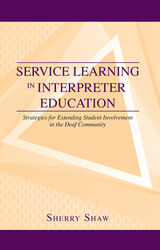
Institutions of higher learning around the nation have embraced the concept of student civic engagement as part of their curricula, a movement that has spurred administrators in various fields to initiate programs as part of their disciplines. In response, sign language interpreting educators are attempting to devise service-learning programs aimed at Deaf communities. Except for a smattering of journal articles, however, they have had no primary guide for fashioning these programs. Sherry Shaw remedies this in her new book Service Learning in Interpreter Education: Strategies for Extending Student Involvement in the Deaf Community.
Shaw begins by outlining how to extend student involvement beyond the field experience of an internship or practicum and suggests how to overcome student resistance to a course that seems atypical. She introduces the educational strategy behind service-learning, explaining it as a tool for re-centering the Deaf community in interpreter education. She then provides the framework for a service-learning course syllabus, including establishing Deaf community partnerships and how to conduct student assessments.
Service Learning in Interpreter Education concludes with first-person accounts from students and community members who recount their personal and professional experiences with service learning. With this thorough guide, interpreter education programs can develop stand-alone courses or modules within existing coursework.

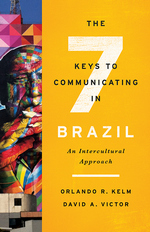
The key to professional success in Brazil is understanding Brazilians. But how do you understand an unfamiliar culture? Seasoned cross-cultural trainers Orlando R. Kelm and David A. Victor use Victor’s groundbreaking approach of evaluating a culture’s language, environment, social organization, context, authority, nonverbal communication, and time conception to provide a framework for understanding Brazilians and show effective strategies to overcome these communication barriers. The method, referred to as the LESCANT approach makes you the expert evaluator of the culture and helps you easily navigate hurdles that can challenge business relationships.
Each chapter of The Seven Keys to Communicating in Brazil employs memorable anecdotes, business cases on each topic from business professionals, and photographs to address key topics. The authors demonstrate how to evaluate the cultural differences between Brazil and North America and include examples of common communication mistakes. Engaging and accessible, the book helps North Americans master the nuances of the Brazilian language and achieve a real experience of the Brasil dos brasileiros.

The key to professional success in Japan is understanding Japanese people. The authors, seasoned cross-cultural trainers for businesspeople, provide a practical set of guidelines for understanding Japanese people and culture through David A. Victor's LESCANT approach of evaluating a culture's language, environment, social organization, context, authority, nonverbal communication, and time conception. Each chapter addresses one of these topics and shows effective strategies to overcoming cultural barriers and demonstrates how to evaluate the differences between Japan and North America to help avoid common communication mistakes. The book is generously peppered with photographs to provide visual examples. Exploring language and communication topics, international relations, and the business community, this book is an excellent intercultural overview for anyone traveling to or working in Japan.

Originally published in cloth in 2001, the paperback includes a new foreword that will inspire all teachers who work with students others have deemed unteachable. A new afterword updates readers on the prison art's program -- and the author herself -- since 2001.

A Short Reference Grammar of Iraqi Arabic is the only volume of its kind, reflecting Iraqi Arabic as spoken by Muslims in Baghdad. With all the Arabic transcribed, it is written for beginners as well as Arabic speakers wanting to learn the dialect. It covers the phonology, morphology (word formation of nouns, verbs, pronouns, adjectives, and numerals, achieved by adding prefixes and suffixes to roots), and syntax, teaching the reader how to make the sounds, form words, and construct sentences.
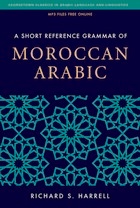
Conceived to be a practical reference grammar for those who may have basic skills in Moroccan Arabic, this classic volume teaches the phonology, morphology, and syntax of the dialect. Originally published in 1962, A Short Reference Grammar of Moroccan Arabic features the spoken language of the urban speakers of the northwestern part of Morocco, especially Fez, Rabat, and Casablanca. The Arabic has been transcribed for the English-speaking student.
The accompanying audio files, keyed to the text, demonstrate the pronunciation of the Arabic transcribed in the book. These mp3 files are available for free online at www.press.georgetown.edu.

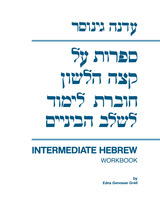
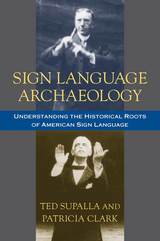
By tracing the writings of selected individuals, this study reconstructs the historical context for early ASL grammar. It describes the language used in each century and how it changed, and focuses on the rediscovery of the literary legacy of the Deaf American voice. Sign Language Archaeology reveals the contrast between folk etymology and scientific etymology and allows readers to see ASL in terms of historical linguistics.
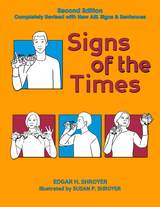
•Completely Revised with New Signs and Lessons
•Each Sign Illustration Features Sentences in English and ASL Order
•New Class Activities and New Student Activities for Homework or Quizzes
•New Facts about American Sign Language Grammar and Deaf Culture
Now, the bestselling American Sign Language textbook Signs of the Times has been completely revised and updated. The new, second edition is an excellent beginner’s American Sign Language textbook designed for use in the classroom or at home. Organized into 44 lessons, it presents more than 1,300 signs representing 3,500 English glosses. Each lesson contains clear illustrations of all signs, English equivalent words and synonyms, sample sentences to define vocabulary context, and practice sentences to display and reinforce ASL usage.
Signs of the Times is a complete text that includes new class activities for teachers, plus new student activities that can be done in class, as homework, or as quizzes. The new edition features the Contextual Sign/Word Appendix, which displays groups of sentences using the same English word to show different meanings along with the corresponding ASL signs. It also provides an expanded index, vocabulary lists, and a reading reference list. The new edition offers facts on ASL grammar and Deaf culture and includes mind ticklers that enliven the lessons with hints, tips, and mnemonic devices.
The new Signs of the Times expands the features that made it a standard, easy-to-use ASL textbook. Signs are repeated in sentences throughout the book to provide excellent practice for the students. The clear, easy-to-understand sign illustrations facilitates the learning process, enhancing students’ success while also making ASL fun.
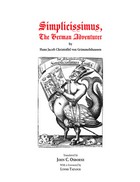
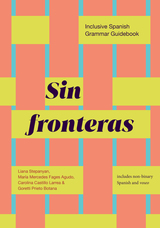
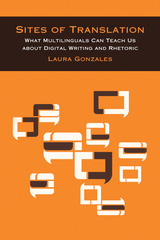
Winner of the 2016 Sweetland Digital Rhetoric Collaborative Book Prize
Sites of Translation illustrates the intricate rhetorical work that multilingual communicators engage in as they translate information for their communities. Blending ethnographic and empirical methods from multiple disciplines, Laura Gonzales provides methodological examples of how linguistic diversity can be studied in practice, both in and outside the classroom, and provides insights into the rhetorical labor that is often unacknowledged and made invisible in multilingual communication. Sites of Translation is relevant to researchers and teachers of writing as well as technology designers interested in creating systems, pedagogies, and platforms that will be more accessible and useful to multilingual audiences. Gonzales presents multilingual communication as intellectual labor that should be further valued in both academic and professional spaces, and supported by multilingual technologies and pedagogies that center the expertise of linguistically diverse communicators.
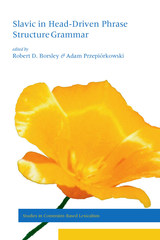
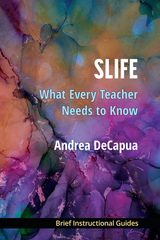

This book provides a clear and comprehensive overview of sociolinguistics and the pragmatics of oral communication in Spanish. Drawing on the research of foremost scholars in the field, Carmen Silva-Corvalán covers central concerns of variational sociolinguistics, discourse analysis, language change, and language contact, with special reference to Spanish in the United States.
A thoroughly revised and expanded version of Silva-Corvalán’s 1989 study, Sociolingüística: teoría y análisis, the book includes rigorous quantitative and qualitative analyses, and it documents such ongoing issues as language change in monolingual and bilingual communities, the nature of phonetic and syntactic variation, and modes of data collection and analysis. New topics include pragmatics and discourse analysis, discourse markers, and sociolinguistics and education.
Written in Spanish, Sociolingüística y pragmática del español will be welcomed by students and sociolinguistic researchers, who will find in it the ideal overview of the social aspects of language as well as a wealth of empirical data on Spanish linguistics. Complete with exercises at the end of each chapter and a convenient subject index, the book is appropriate for advanced undergraduates and graduate students of Spanish throughout the world.

This thoroughly updated second edition provides a clear and comprehensive overview of sociolinguistics and the pragmatics of oral communication in Spanish. While maintaining the same structure as the first edition, it includes revised “Ejercicios de reflexión” and new comprehension checks at the end of each chapter, along with numerous bibliographic references throughout, enhancing its use as a classroom text. Among the significant revisions are new sections on corpus linguistics and on statistical modeling programs for studying linguistic variables, an expanded chapter on the study of linguistic attitudes with special attention to Spanish in the United States, greater attention to the relation of pragmatics to sociolinguistics, including coverage of verbal politeness and forms of address, and updated information on Spanglish and on the teaching of Spanish as a heritage language.
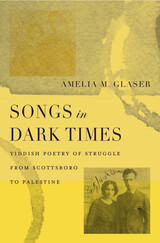
A probing reading of leftist Jewish poets who, during the interwar period, drew on the trauma of pogroms to depict the suffering of other marginalized peoples.
Between the world wars, a generation of Jewish leftist poets reached out to other embattled peoples of the earth—Palestinian Arabs, African Americans, Spanish Republicans—in Yiddish verse. Songs in Dark Times examines the richly layered meanings of this project, grounded in Jewish collective trauma but embracing a global community of the oppressed.
The long 1930s, Amelia M. Glaser proposes, gave rise to a genre of internationalist modernism in which tropes of national collective memory were rewritten as the shared experiences of many national groups. The utopian Jews of Songs in Dark Times effectively globalized the pogroms in a bold and sometimes fraught literary move that asserted continuity with anti-Arab violence and black lynching. As communists and fellow travelers, the writers also sought to integrate particular experiences of suffering into a borderless narrative of class struggle. Glaser resurrects their poems from the pages of forgotten Yiddish communist periodicals, particularly the New York–based Morgn Frayhayt (Morning Freedom) and the Soviet literary journal Royte Velt (Red World). Alongside compelling analysis, Glaser includes her own translations of ten poems previously unavailable in English, including Malka Lee’s “God’s Black Lamb,” Moyshe Nadir’s “Closer,” and Esther Shumiatsher’s “At the Border of China.”
These poets dreamed of a moment when “we” could mean “we workers” rather than “we Jews.” Songs in Dark Times takes on the beauty and difficulty of that dream, in the minds of Yiddish writers who sought to heal the world by translating pain.

Sonido y sentido lifts the learning of Spanish pronunciation for American English-speaking students to a new level, with support of an accompanying CD. Written in Spanish by a native speaker who is a leading figure in the field of Spanish phonology, this introduction to Spanish phonetics and phonology will improve both the pronunciation and understanding of spoken Spanish by demonstrating the specific ways in which the sound pattern of Spanish differs from English. Notable in that it explains the "why" of pronunciation with specific information on how the sounds of Spanish are organized—it also highlights the most important differences among varieties within the Spanish-speaking world. Together, the book and CD emphasize the sounds and sound combinations that are most problematic for English speakers learning Spanish.
In addition to a clear theoretical analysis of Spanish phonology, Sonido y sentido introduces the fundamental concepts of language, Spanish language, and the teaching and learning of phonetics—Spanish phonetics in particular. Utilizing the International Phonetic Alphabet (IPA) throughout the text to make for more precise phonetic descriptions, Guitart also discusses the relation between both the physical and psychological aspects of pronunciation.
Sonido y sentido contains exercises, both transcription and pronunciation drills, and each chapter concludes with a section, "Para pensar," which tests comprehension of the concepts presented. Answers to the "Para pensar" exercises appear in a separate appendix. A glossary of technical terms, a subject index, and a basic bibliography of Spanish phonetics and phonology round out this fresh and rewarding contribution to learning the Spanish language.
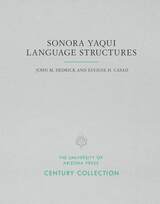
The book includes useful sections on quantifiers and adverbial and deictic particles, often inadequately treated in reference grammars. A section on auxiliary verbs and well-documented information on voice, aspect, and other features of verbal inflection provide readers with useful data for particular lines of linguistic inquiry. Each grammatical point is illustrated by example sentences distinguished by their naturalness and cultural relevance. At the end of the book, a Yaqui text provides a sample of connected sentences in a natural context.
Sonora Yaqui Language Structures is a valuable source not only for research on this language family but also for anthropological studies of the Arizona-Sonora cultural region. In addition, it documents an indigenous language for future generations of Yaqui speakers.

Sons et sens presents a unique cultural approach to French pronunciation for English-speaking students. Each chapter presents a new cultural topic, such as the French education system, vernacular French, and cooking in the francophone world, in order to enhance students’ pronunciation skills within the context of French and francophone culture. Phonetic explanations and rules throughout the textbook are anchored in recent research on French phonology, reflecting contemporary French as well as elements of nonstandard variation from around the francophone world. The authors' approach derives from current research on second language acquisition and pedagogy as well as contemporary research on French linguistics—especially sociolinguistics.
The textbook’s fifteen chapters include a variety of exercises on sound discrimination, rule formulation, phonetic reading and transcriptions, and conversations. The publisher's website (press,georgetown.edu) provides about 200 sound files and several video files that show how sounds are formed with the body. A teacher's edition contains additional materials, including comments and answers keyed to the student text. Perfect for third year students, Sons et sens should appeal to instructors and students of college-level pronunciation and phonetics courses and serve as a valuable reference in a variety of courses where pronunciation is of importance. The book will also interest students with some background in French who want to perfect their pronunciation on their own.
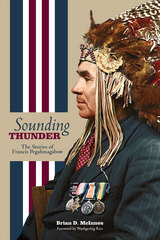
Francis Pegahmagabow’s stories describe many parts of his life and are characterized by classic Ojibwe narrative. They reveal aspects of Francis’s Anishinaabe life and worldview. Interceding chapters by Brian McInnes provide valuable cultural, spiritual, linguistic, and historical insights that give a greater context and application for Francis’s words and world. Presented in their original Ojibwe as well as in English translation, the stories also reveal a rich and evocative relationship to the lands and waters of Georgian Bay.
In Sounding Thunder, Brian McInnes provides a new perspective on Pegahmagabow and his experience through a unique synthesis of Ojibwe oral history, historical record, and Pegahmagabow family stories.
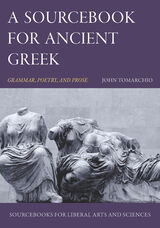

A staple of southwestern health care for more than twenty years, this dictionary can make a difference in patient care. Now available in a revised edition, it focuses on vocabulary used in health contexts by Spanish-speaking people in order to help patients tell their stories and medical practitioners to understand them. Unlike other bilingual dictionaries that emphasize scientific terms, this one focuses on standard Spanish terms as well as regional expressions peculiar to Mexican Spanish—language encountered in Chicago as easily as in Phoenix.
In the Spanish-to-English section, Spanish terms are followed by English translations and sample sentences to help health care practitioners understand how a patient might use them:
acedías, heartburn, pain in lower esophagus perceived as in the heart. Uno tiene la tendencia a sufrir de acedías después de comer chile. One has a tendency to suffer heartburn after eating chile. (syn: acidez, agruras del estómago)
In the English-to-Spanish section, English words are translated into simple Spanish terms along with English synonyms.
Now available in a revised edition, this handy reference features:
• more than 3,000 entries
• new entries that reflect current health problems and treatments
• inclusion of cognates
• Spanish definitions of English words
• anatomical drawings with bilingual labels
• more material on medicinal plants, including an appendix of poisonous and non-poisonous plants
• lists of food items and kinship terms
This book is an indispensable reference for all health care professionals who see patients of Mexican origin. Combining idiomatic precision with technical accuracy, it can help break down language barriers on either side of the border.

This collection is the first to examine the effects of bilingualism and multilingualism on the development of dialectal varieties of Spanish in Africa, America, Asia and Europe. Nineteen essays investigate a variety of complex situations of contact between Spanish and typologically different languages, including Basque, Bantu languages, English, and Quechua. The overall picture that evolves clearly indicates that although influence from the contact languages may lead to different dialects, the core grammar of Spanish remains intact.
Silva-Corvalán's volume makes an important contribution both to sociolinguistics in general, and to Spanish linguistics in particular. The contributors address theoretical and empirical issues that advance our knowledge of what is a possible linguistic change, how languages change, and how changes spread in society in situations of intensive bilingualism and language contact, a situation that appears to be the norm rather than the exception in the world.
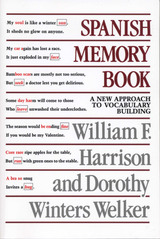
Using mnemonics is an age-old technique for remembering names, numbers, and many other things. In Spanish Memory Book, William Harrison and Dorothy Welker offer original mnemonic rimes that are by turns amusing, ironic, pathetic, sentimental, and sardonic to help students and independent learners acquire and remember Spanish vocabulary.
Included are mnemonic jingles for 700 of the 2,000 most commonly used Spanish words. Each jingle contains both the sound of the Spanish word and its English meaning. The authors have included a general pronunciation guide to Spanish vowels and consonants.
This innovative approach, which the authors have used successfully with their own students, is simple, effective, and entertaining. In the words of one student, "This book teaches me not only Spanish words but English words as well."
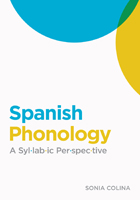
Spanish Phonology offers a comprehensive analysis of a variety of crucial issues in the phonology and morphophonology of various dialects of Spanish including syllable types, syllabification algorithms, syllable repair mechanisms, syllable mergers, nasal assimilation, obstruent vocalization and spirantization, obstruent neutralization, diphthongs and hiatuses, glide formation, onset strengthening, aspiration, rhotics, velarization, plural formation, word classes, and diminutives.
Written from the perspective of optimality theory and with syllabic structure at its core, this volume highlights recent advances in Spanish phonology.
The book includes margin notes to highlight key points and a glossary of constraints. Each chapter includes study questions, lists of the most influential sources for each chapter, and topics for further research. Spanish Phonology is intended as core reading for advanced phonology courses in Spanish linguistics, general linguistics, and related areas such as bilingualism, language variation, language acquisition, and speech and hearing.

Spanish Phonology and Morphology serves as an introduction to both the formal study of Spanish phonology and the framework of generative phonology.
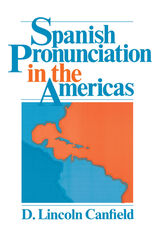

Spanish Second Language Acquisition provides a panoramic overview of previous studies on the acquisition of Spanish as a second or foreign language, the theoretical approaches used in these studies, and the effects of various pedagogical approaches on the development of Spanish interlanguage systems. Barbara Lafford and Rafael Salaberry have compiled the first volume to provide a comprehensive critical overview of the research done and data compiled on how adults acquire Spanish as a second language. Major scholars in the field of SLA have contributed chapters having to do with a wide range of "products" (phonology, tense/aspect, subjunctive, clitics, lexicon, discourse/pragmatics) and "processes" (generative, cognitive and sociocultural theories) involved in the acquisition process-concluding with a discussion of the effects of instruction on Spanish interlanguage development.
While being an invaluable reference tool for undergraduate and graduate programs that focus on the acquisition of Spanish as a second language, due to the extraordinary range of the review research on theoretical and methodological issues, this is also an extremely useful volume for second language theoreticians and practitioners involved in all aspects of the pedagogy of other second languages. It is the editors' desire that students, teachers, program administrators and scholars alike will benefit from the insights that the contributors bring to the myriad issues that language professionals confront.
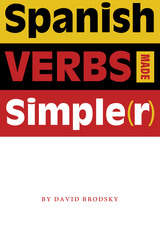
It's time for a new approach to learning Spanish verbs. Unlike popular verb guides that require the rote memorization of hundreds of verb forms, this book clearly explains the rules that govern the conjugation of all classes of Spanish verbs—especially the irregular ones that give second-language learners the most trouble. These simple, easy-to-understand rules for conjugating Spanish verbs are effective learning tools for both beginning students and more advanced speakers who want to perfect their usage of Spanish verb forms.
Spanish Verbs Made Simple(r) has many helpful features that you won't find in any other verb guide:
- Clear explanations of all verb tenses and forms.
- The simple rules that govern the conjugation of all verbs—including the 90% of irregular verbs whose irregularities are entirely predictable.
- A detailed discussion of how each verb form is used, with numerous examples.
- A full explanation of the distinction between ser and estar—the single most confusing element in the Spanish verbal system.
- An extended treatment of the subjunctive that will help you understand why it is used in some situations but not others.
- Conjugations for 35 model Spanish verbs and a comprehensive listing of 4,800 verbs that indicates which of the models each verb follows.
Going well beyond any other guide in the clarity and detail of its explanations—as well as the innovative manner in which individual verbs are linked to model conjugations—Spanish Verbs Made Simple(r) is the only guide to Spanish verbs a learner needs.
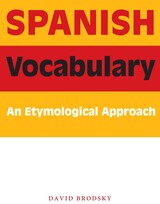
Unlike other vocabulary guides that require the rote memorization of literally thousands of words, this book starts from the premise that using the etymological connections between Spanish and English words—their common derivations from Latin, Greek, and other languages—is the most effective way to acquire and remember vocabulary. This approach is suitable for beginners as well as for advanced students. Teachers of the language will also find much material that can be used to help motivate their students to acquire, and retain, Spanish vocabulary.
Spanish Vocabulary is divided into four parts and four annexes:
- Part I provides background material on the origins of Spanish and begins the process of presenting Spanish vocabulary.
- Part II presents "classical" Spanish vocabulary—words whose form (in both Spanish and English) is nearly unchanged from Latin and Greek.
- Part III deals with "popular" Spanish vocabulary, which underwent significant changes in form (and often meaning) during the evolution from Latin to Spanish. A number of linguistic patterns are identified that will help learners recognize and remember new vocabulary.
- Part IV treats a wide range of themes, including words of Germanic and Arabic origin, numbers, time, food and animals, the family, the body, and politics.
- Annex A: Principal exceptions to the "Simplified Gender Rule"
- Annex B: 700 words whose relations, if any, to English words are not immediately obvious
- Annex C: -cer verbs and related words
- Annex D: 4,500 additional words, either individually or in groups, with English correspondences

An invaluable text in language and linguistics because it has a unique scope: a one-volume description of the Spanish language and its differences from English, and ranges from pronunciation and grammar to word meaning, language use, and social and dialectical variation. Designed for survey courses in Spanish linguistics with technical concepts explained in context for beginners in the field, Spanish/English Contrasts brings out the ways in which insights into the two languages have evolved as scholars have built on the work and research of others in the field. A bilingual glossary of linguistic terms is provided to facilitate discussion in either language.
This second edition is thoroughly updated to incorporate insights and issues that have come to the fore from the explosion of research in the past twenty-five years in all of the areas covered by the book. It includes an expanded bibliography and index, and adds new exercises for student application and class discussion. Its approach remains broadly based however, in order to accommodate a range of areas and data rather than focusing narrowly on one single theory or research area, and it continues to emphasize implications for language teaching, translation, and other practical applications.

Most previous analyses of spatial prepositions have assumed that their semantic properties can be adequately explained by familiar logical and geometrical concepts. Thus, the standard view of the preposition "in" as it appears in the sentence "the ball is in the bag" postulates that it refers to the geometrical relation of inclusion. This paradigm, however, falters when faced with the contrast in acceptability between sentences such as "the bulb is in the socket" and "the bottle is in the cap." The force exerted by the "landmark" (a conceptually fixed object) on the "target" (a moveable object) is crucial in this difference: the functional notion of containment seems more operational in the use of the preposition "in" than inclusion. That is, what are taken to be the landmark and the target depend greatly on the functions these objects serve in the human scheme. This offers important clues to otherwise problematic linguistic quirks, such as why one sleeps in one's bed, while one is said to lie on one's deathbed.
While many of the examples apply in English as well as French, there are some noteworthy differences—in French one sits on a chair, but in a couch. Vandeloise convincingly argues that it is precisely this subjective element which makes a standard geometrical account unfeasible.
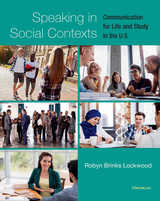
The text provides language to use for a variety of functions as they might related to life on a university campus: offering greetings and goodbyes, making introductions, giving opinions, agreeing and disagreeing, using the phone, offering assistance, asking for advice, accepting and declining invitations, giving and receiving compliments, complaining, giving congratulations, expressing condolences, and making small talk. Users are also taught to think beyond the words and to interpret intonation and stress (how things sound).
Each of the 10 units includes discussion prompts, language lessons, practice activities, get acquainted tasks (interacting with native speakers), and analysis opportunities (what did they discover and what can they apply?).
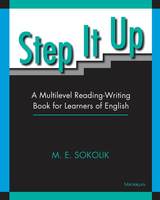
Each chapter focuses on a different academic discipline (education, art, history, business, geology, ecology, nutrition, language and culture, and literature). Chapters include three readings at three fluency levels-called the First Step (intermediate), Second Step (high-intermediate to low-advanced), and Third Step (advanced). Corresponding vocabulary development exercises, comprehension questions, group discussion questions, and wrap-up activities encourage students to work at their own learning levels even as they are asked to interact with the group and share the expertise that they have gained from the material.
Step It Up can also address the needs of learners who don't fall into the traditional categories and who will benefit from activities at different levels to help fill in gaps of their knowledge of English.
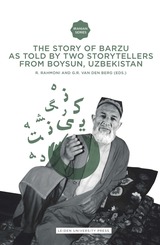
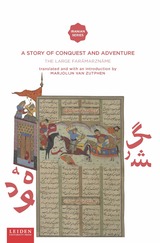

Swahili was once an obscure dialect of an East African Bantu language. Today more than one hundred million people use it: Swahili is to eastern and central Africa what English is to the world. From its embrace in the 1960s by the black freedom movement in the United States to its adoption in 2004 as the African Union’s official language, Swahili has become a truly international language. How this came about and why, of all African languages, it happened only to Swahili is the story that John M. Mugane sets out to explore.
The remarkable adaptability of Swahili has allowed Africans and others to tailor the language to their needs, extending its influence far beyond its place of origin. Its symbolic as well as its practical power has evolved from its status as a language of contact among diverse cultures, even as it embodies the history of communities in eastern and central Africa and throughout the Indian Ocean world.
The Story of Swahili calls for a reevaluation of the widespread assumption that cultural superiority, military conquest, and economic dominance determine a language’s prosperity. This sweeping history gives a vibrant, living language its due, highlighting its nimbleness from its beginnings to its place today in the fast-changing world of global communication.

For centuries, poets have turned to translation for creative inspiration. Through and in translation, poets have introduced new poetic styles, languages, and forms into their own writing, sometimes changing the course of literary history in the process. Strange Cocktail is the first comprehensive study of this phenomenon in modern Hebrew literature of the late nineteenth century to the present day. Its chapters on Esther Raab, Leah Goldberg, Avot Yeshurun, and Harold Schimmel offer close readings that examine the distinct poetics of translation that emerge from reciprocal practices of writing and translating. Working in a minor literary vernacular, the translation strategies that these poets employed allowed them to create and participate in transnational and multilingual poetic networks. Strange Cocktail thereby advances a comparative and multilingual reframing of modern Hebrew literature that considers how canons change and are undone when translation occupies a central position—how lines of influence and affiliation are redrawn and literary historiographies are revised when the work of translation occupies the same status as an original text, when translating and writing go hand in hand.
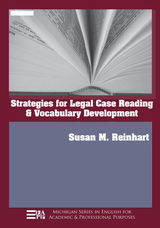
Strategies for Legal Case Reading and Vocabulary Development begins with an overview of the American legal system and relevant research and guidelines relating to case reading. The book is divided into sections on common law, statutory law, and constitutional law. Approximately twenty cases (some abridged) and eight readings are included in the text. Questions for Discussion follow each case to help students prepare to actively participate in class case discussions. Additional features include hypotheticals (often posed by law professors), vocabulary tasks, and short writing assignments.

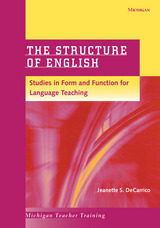
With an emphasis on discourse function throughout, students are never expected to rely on lists of unrelated, constructed example sentences. Rather, when major points of grammar are presented, the structures are illustrated with rich, "real world" contexts excerpted from literature (mostly American), including novels, short stories, poems, essays, and drama. Exercises in the companion workbook are likewise based on naturally occurring stretches of discourse.
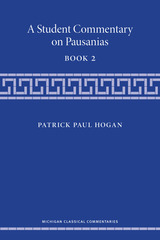
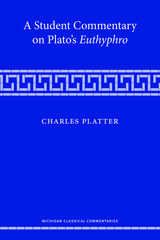
This accessible student commentary by Charles Platter presents an introduction to the Euthyphro, the full Greek text, and a commentary designed for undergraduates and selected graduate students. As part of the series Michigan Classical Commentaries, now edited by Josiah Osgood and Alexander Sens at Georgetown University, and K. Sara Myers at the University of Virginia, the volume is sized and priced for student use.
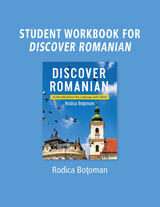
Student Workbook for Discover Romanian: An Introduction to the Language and Culture by Rodica Boțoman

Intended for the general student of the Indonesian language and the professional linguist, this short descriptive grammar is a useful guide as a well as a point of departure for more intensive study.


The editors and fourteen other research linguists discuss—in English and in Spanish—the African influence on Caribbean phonology, dominant sociolinguistic attitudes in Puerto Rico, and historico-legal aspects of bilingualism in colonial Hispanic America.
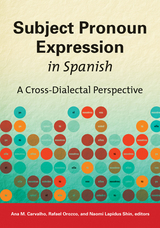
Much recent scholarship has sought to identify the linguistic and social factors that favor the expression or omission of subject pronouns in Spanish. This volume brings together leading experts on the topic of language variation in Spanish to provide a panoramic view of research trends, develop probabilistic models of grammar, and investigate the impact of language contact on pronoun expression.
The book consists of three sections. The first studies the distributional patterns and conditioning forces on subject pronoun expression in four monolingual varieties—Dominican, Colombian, Mexican, and Peninsular—and makes cross-dialectal comparisons. In the second section, experts explore Spanish in contact with English, Maya, Catalan, and Portuguese to determine the extent to which each language influences this syntactic variable. The final section examines the acquisition of variable subject pronoun expression among monolingual and bilingual children as well as adult second language learners.
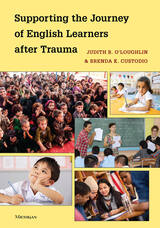
This book is designed to provide a practical resource to help educators better understand the possible traumatic backgrounds of their students and how that could be affecting their academic, social, and emotional lives. It also focuses on how school personnel can create a safe environment in schools and classrooms to help students recognize, nurture, and expand the internal resilience that has enabled them to weather past situations and that will allow them to continue the healing process.
One chapter is devoted to the topic of self-care for educators who are working so hard to help students be resilient. An appendix features a list of recommended books on the topics of personal migration and resilience.

Kiswahili has become the lingua franca of eastern Africa. Yet there can be few historic peoples whose identity is as elusive as that of the Swahili. Some have described themselves as Arabs, as Persians or even, in one place, as Portuguese. It is doubtful whether, even today, most of the people about whom this book is written would unhesitatingly and in all contexts accept the name Swahili.
This book was central to the thought and lifework of the late James de Vere Allen. It is his major study of the origin of the Swahili and of their cultural identity. He focuses on how the African element in their cultural patrimony was first modified by Islam and later changed until many Swahili themselves lost sight of it.
They share a language and they share a culture. Their territory stretches from the coast of southern Somalia to the Lamu archipelago in Kenya, to the Rovuma River in modern Mozambique and out into the islands of the Indian Ocean. But they lack a shared historical experience.
James de Vere Allen, in this study of contentious originality, set out to give modern Swahili evidence of their shared history during a period of eight centuries.
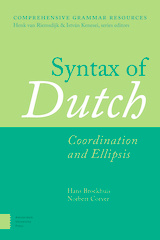
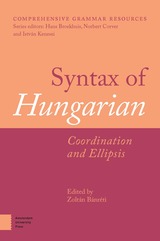
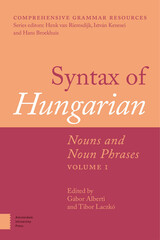
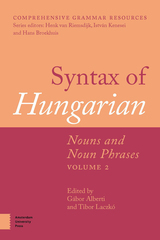

This book is the first comparative study of the syntax of Arabic dialects, based on natural language data recorded in Morocco, Egypt, Syria, and Kuwait. These four dialect regions are geographically diverse and representative of four distinct dialect groups.
Kristen E. Brustad has adopted an analytical approach that is both functional and descriptive, combining insights from discourse analysis, language typology, and pragmatics—the first time such an approach has been used in the study of spoken Arabic syntax. An appendix includes sample texts from her data.
Brustad's work provides the most nuanced description available to date of spoken Arabic syntax, widens the theoretical base of Arabic linguistics, and gives both scholars and students of Arabic tools for greater cross-dialect comprehension.
READERS
Browse our collection.
PUBLISHERS
See BiblioVault's publisher services.
STUDENT SERVICES
Files for college accessibility offices.
UChicago Accessibility Resources
home | accessibility | search | about | contact us
BiblioVault ® 2001 - 2024
The University of Chicago Press









